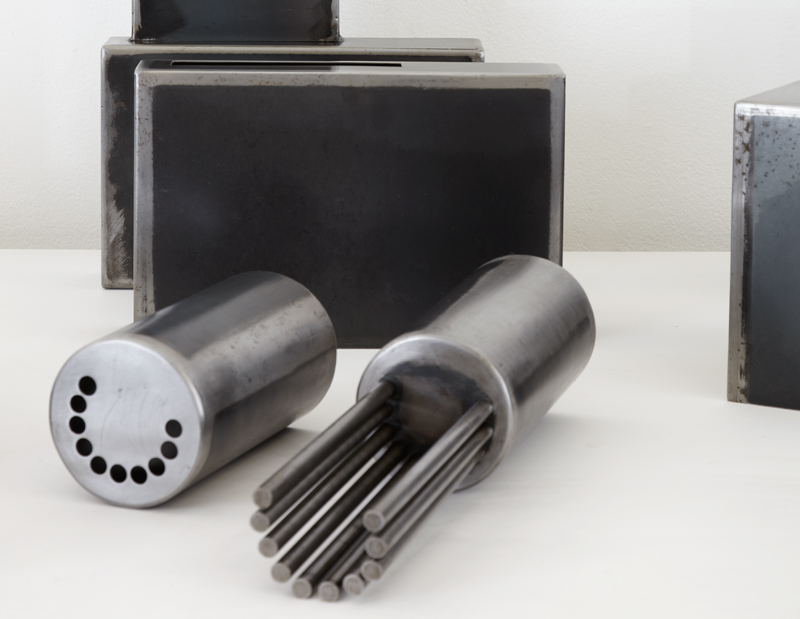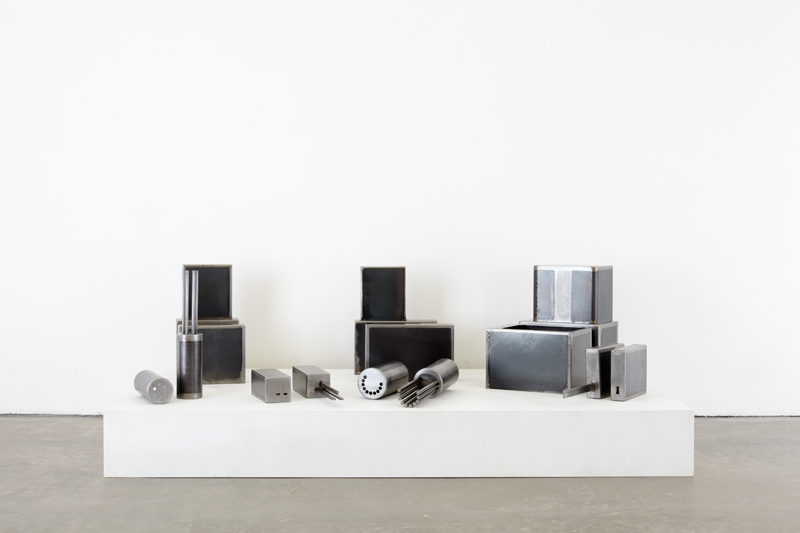Curated by Jonathan Watkins, Jenine McGaughran and Stuart Tulloch, 'As Exciting As We Can Make It' is a survey of Ikon’s programme from 1978 to 1989
‘Exits’, built in 1986, was shown two years later in the Grey Matter New Sculpture exhibition at the Ikon Gallery. Then in 1989 it was shown at the Orchard Gallery in Derry/Londonderry.
In 1985 I had returned from America where I had been making works in different sites and civic situations on both the West and East coasts. I had been working in America as the first recipient of a Fulbright fellowship in Visual Art. It had been a year of experimentation that was to become pivotal in my thinking about art and its relationship to places and people.
Increasingly I was looking at possibilities of exchange between people and art works. I had begun to speculate on the filters that shaped situations as exchanges. It was a time when I was looking closely at how events, laws and values connected the relationships of life to art.
1986 The year edited
The year opened with Michael Heseltine and Leon Brittan resigning over the Westland scandal and unemployment increased to a post war high of over three million. In Wapping, News International had prepared a new printing plant so that when the print unions called a strike the new plant was activated and dismissal notices given to all strikers. Like the Miners’ strike before, the Wapping dispute saw demonstrations playing out nightly on the evening news. There was a sense that the future of newspapers was in the balance. Then in March The Sun alleged that Freddie Starr had eaten a live hamster.
As spring approached there was a feeling that WB Yeats had described, that the centre could not hold and things were falling apart. April brought little respite with prison riots breaking out across the country. The Thatcher government was defeated when the bill that would have liberalised Sunday shopping was rejected on the second reading, but the process had begun. June saw England beaten in the world cup quarter finals in Mexico in a 2–1 defeat by Argentina. This was the infamous ‘Hand of God’ incident when Diego Maradona was allowed a blatantly handballed goal. Argentina went on to win the world cup.
Spirits sank further in July as rioting broke out in Portadown, Northern Ireland between Protestants and Catholics and it was announced that unemployment rose to 3,220,400. In August there were more football gang clashes and UEFA banned English clubs from European competition for a further year. The same month also saw the privatisation of the National Bus Company followed later by the start of bus deregulation.
In September GCSE exams replaced GCE and CSE courses. The floatation of the Trustee Savings Banks attracted more than 4 million applications for shares. In October Jeffrey Archer resigned as the deputy leader of the Conservative party over a scandal concerning prostitutes.
On Big Bang day the London Stock Exchange was computerised and opened to foreign companies. With a name that aspired to indicate the beginning of universes was an indication of the bewildering insensitivities being demonstrated. I did sense at the time that this was going to widen all the gaps in our society. Again, I felt like Yeats ‘Turning and turning in the widening gyre’.
The year drew to close with 4 million people applying for shares in British Gas. The initial public offering valued the company at £9 billion, the highest equity offering ever at this time. In many ways you can say; same as it ever was. But for me it felt like our social realm was falling inward to a place that, at best, was a nihilistic void where greed superseded generosity and we were being lost in an ever growing chasm between those that had and those that had not; where a majority of people would eventually be beyond the pale with just a select few playing within a redefined pale. 1986
Exits
In 1985 I was living with Ann and our three year old son Jack in a comfortable, happy and busy house. Ann was teaching and Jack was doing what three olds do in exploring everything. I was making art and working part time at Nottingham Trent University.
My work was being sought after by dealers in London and Cologne and public galleries were showing interest. I was developing my thoughts about place and art and people. Life was good but the news wasn’t. Part of the building of ‘Exits’, may have been that I was worried about how the social and economic climate outside our home threatened what we had in it.
‘Exits’ emerged from a conceptual cartography that responded to the drone of the years events seeping into our home. The art seeped out of our house to a wider set of situations beyond. Our home informed my thoughts and values and my practice emerged from them. I saw our house as a filter, both actual and metaphorical, of social, economic and political events.
‘Exits’ was developed from this filter as the physical holes in our house. Plug socket, television, a telephone dial, sink and bath plug holes, a VHS cassette player, key holes and a letter box were the spaces I chose. I thought of these spaces as moulds of the filter.
I made a decision to construct a sculptural work that was uncluttered in its aesthetic. I set about fabricating faithful moulds of each these holes or filters. Working in Spanish mild black steel I extended each exit mould by 9 inches following or extending the form of each object. From the moulds I set to work on making corresponding forms that would fit or plug the moulds. The plugging elements were made to 9 inches and its extension was a further 9 inches making these correspondent works 18 inches in length.
The first showing of ‘Exits’ had the work positioned on a on three door sized steel elements that extended the analogy and ran end to end forming a long low plinth of approximately eighteen feet.
By placing the mould and its plug together the work began to suggest a potential of blocking or unblocking the filter. It became a material metaphor of a condition of art where the social, political and the economic tributaries of our lives could be plugged or unplugged as filters to our all our houses; a kind of threshold to closing down or opening up. It is what art, in part, did.
There were sister works to ‘Exits’ made in the same year; including a work that reproduced every window in our house as a blank steel mould forming ‘plugged’ forms from them. Looking back much feels familiar. Ann and I now live nearby but in a different house. Jack lives and works in London but ours is still a full and happy house. Our glimpses outwards still note the events and values that the news brings. The threat I felt to our home still exists as it does in most homes around the world… same as it ever was.
John Newling (October 2013)

